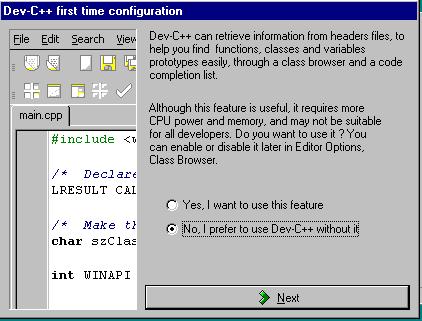Find Next In Dev C++
C Program to Check Leap Year This program checks whether an year (integer) entered by the user is a leap year or not. To understand this example, you should have the knowledge of the following C programming topics.
- Previous Next C Strings. Strings are used for storing text. A string variable contains a collection of characters surrounded by double quotes: Example. Create a variable of type string and assign it a value: string greeting = 'Hello'.
- May 26, 2010 Learn to create your first C program using Dev-C. Learn to create your first C program using Dev-C. A suggested video will automatically play next. Up next How to Use Dev C.
- Jun 24, 2016 C program to find prime numbers in a given range, C Program to Print next Prime number, C Program to Check If the number is Prime or not. CodeBind.com Free Programming Tutorials and Lessons By ProgrammingKnowledge.
- C++ Basics
- C++ Object Oriented
- C++ Advanced
- C++ Useful Resources
- Selected Reading
Nikon d850 auto af fine tune failed. A for loop is a repetition control structure that allows you to efficiently write a loop that needs to execute a specific number of times.
Syntax
The syntax of a for loop in C++ is −
Here is the flow of control in a for loop −
The init step is executed first, and only once. This step allows you to declare and initialize any loop control variables. You are not required to put a statement here, as long as a semicolon appears.
Next, the condition is evaluated. If it is true, the body of the loop is executed. If it is false, the body of the loop does not execute and flow of control jumps to the next statement just after the for loop.
After the body of the for loop executes, the flow of control jumps back up to the increment statement. This statement can be left blank, as long as a semicolon appears after the condition.
The condition is now evaluated again. If it is true, the loop executes and the process repeats itself (body of loop, then increment step, and then again condition). After the condition becomes false, the for loop terminates.
Flow Diagram
Example
When the above code is compiled and executed, it produces the following result −
- C++ Basics
- C++ Object Oriented
- C++ Advanced
- C++ Useful Resources
- Selected Reading
A goto statement provides an unconditional jump from the goto to a labeled statement in the same function.
NOTE − Use of goto statement is highly discouraged because it makes difficult to trace the control flow of a program, making the program hard to understand and hard to modify. Any program that uses a goto can be rewritten so that it doesn't need the goto.

Syntax
The syntax of a goto statement in C++ is −
Where label is an identifier that identifies a labeled statement. A labeled statement is any statement that is preceded by an identifier followed by a colon (:).
Find Next In Dev C Download
Flow Diagram
Example
When the above code is compiled and executed, it produces the following result −
One good use of goto is to exit from a deeply nested routine. For example, consider the following code fragment −
Eliminating the goto would force a number of additional tests to be performed. A simple break statement would not work here, because it would only cause the program to exit from the innermost loop.